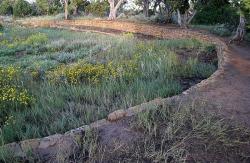
Four prehistoric reservoirs at Mesa Verde National Park were constructed and used between AD 750 and AD 1180. They are: Morefield Reservoir (in Morefield Canyon), Far View Reservoir (on Chapin Mesa), Sagebrush Reservoir (on an unnamed mesa), and Box Elder Reservoir (in Prater Canyon). These four ancient reservoirs represent extraordinary engineering achievements by the Ancestral Puebloan people. In an arid environment with very little surface water, these prehistoric people found ways to route and capture runoff to create sustainable domestic water supply reservoirs.
Morefield and Box Elder Reservoirs were valley-bottom structures that captured intermittent stream channel flows. They originated as excavated ponds on the valley floor and both became elevated after the siltation and resultant dredging of years of use. Far View (shown above) and Sagebrush Reservoirs are mesa-top features that captured harvested water. Deforestation and the packing of surrounding ground surface by foot traffic resulted in increased runoff water.
Facts:
- Maize pollen is present in soil samples taken from these sites, proving nearby agriculture.
- Reservoirs were operated successfully over hundreds of years; the evidence at Morefield, for example, indicates about 350 years of continuous maintenance and operation.
- Examination of reservoir sediment deposits and potsherds can provide a sequential record of human activities and timeline data.
- Dredging was necessary at all four reservoirs to maintain storage capacity.
- Stone walls were built at Far View and Sagebrush Reservoirs to retain dredged sediment.
- The Ancestral Puebloans harvested water supply from areas where modern engineers would say there was none.
- The Ancestral Puebloans had good rudimentary knowledge of hydrological phenomena, water transport and storage.
- Without good organizational capabilities, such large, continuously operated public works projects would not have been possible.
- All four Mesa Verde reservoirs are on an east-west straight line.


